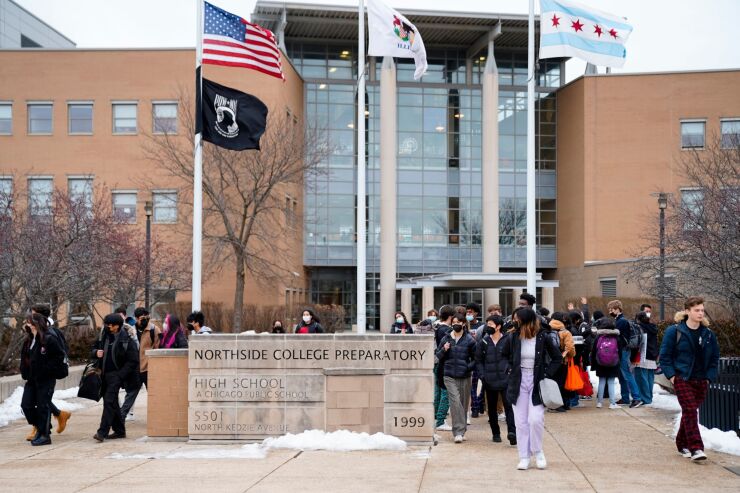Chicago Public Schools is proposing to spend $9.5 billion in the next fiscal year after closing the books June 30 with an expected $1 billion fund balance and no short-term debt outstanding.
Both measurements — tracked closely by market participants and rating agencies and key to the district returning to investment grade status — are improved, with help from federal pandemic relief.
Proposed operational spending is up by $200 million from the current fiscal year. About $4.6 billion would go directly to schools, up by $240 million.

"These investments will set the foundation for what CPS students can expect in classrooms, from reasonable class sizes to more staff members working to tap the full potential of our bright and talented children,” Mayor Lori Lightfoot, who officially launched her campaign for a second term Wednesday, said in CPS’ budget statement.
The
The remaining funds “will be invested strategically through FY2025 to address the evolving needs of our students and school communities,” schools chief Pedro Martinez said in a statement. The district anticipates spending $607 million in fiscal 2024 and $200 million in fiscal 2025.
A proposed $765 million capital plan relies on $550 million of borrowing, $152 million of tax-increment financing funding, and $50 million from the state, with several smaller sources making up the remainder.
CPS operates 522 campuses and 803 buildings with the average facility age at more than 80 years. CPS’ five-year capital plan calls for reduced spending in future years in the range of $553 million annually after 2023.
Heading into the pandemic the district had made fiscal strides from reducing its reliance on short-term borrowing to rebuilding fund balances and reserves. The federal relief has helped both fund social and educational investments while also making further fiscal progress but market participants worry over whether the district can maintain and achieve further gains.
The district expects to close the books on fiscal 2022 with a $1 billion unrestricted general fund balance that would be maintained through 2023. While on the rise, it will still fall short of a 15% target of the operating and debt service budget adopted in a January 2021 to reflect Government Finance Officers’ Association’s best practices. To hit the target, CPS would need to build the reserve to $1.2 billion.
“In FY2022, CPS projects an additional $229 million in the district’s fund balance due to end-of-year revenues exceeding expenditures by that amount,” budget documents read. “CPS will likely remain short of the updated general fund target. CPS is confident that its strengthened financial position and the availability of new federal resources will allow it to meet the revised target in coming years."
The district had drained fund balances to manage deficits before receiving new state funding in 2017 along with local help through a pension levy and other sources.
On the liquidity front, CPS will continue to rely on tax anticipation note borrowing to manage cash flow as it awaits state aid and property tax payments. CPS has reduced its short-term borrowing by about $750 million after hitting highs of $1.55 billion more than five years ago with investors then demanding steep interest rate penalties for the district’s fiscal woes.
“In FY2022, CPS issued a maximum of $800 million in TANs to support liquidity. As of June 30, 2022, it is projected that no TANs are outstanding compared to $244 million outstanding in FY2021,” CPS budget documents read. “This improvement was caused through a combination of factors including a higher fund balance, federal stimulus revenues, and other timing of revenues and expenditures.”
The district is also increasing the number of months without TANs outstanding to four from two. CPS expects to issue TANs against the second installment of property taxes as the need arises. The next tax bills are expected to go out late, but the timing is not yet clear nor how that would impact CPS’ borrowing plans.
The district’s local funding sources are projected to rise next year with an additional $310 million in property taxes and $145 million from the personal property replacement tax on corporations. The district expects $96 million from a city-declared TIF surplus, down $40 million from this year. State aid will rise by $62 million to $1.6 billion as the state’s budget fully funds the annual $350 million increase under an evidence-based formula adopted in 2017.
The state formula changes hold the district’s aid levels harmless based on enrollment, a good thing since the district continues to suffer annual student declines including a 10,000 drop last fall.
CPS complains in budget documents that the increased funding from both the formula change and new state support for pensions still fall short by $1.8 billion based on its needs.
The budget includes $175 million to cover pension payments for the district’s non-teaching staff who participate in the city’s Municipal Employees’ Annuity and Benefit Fund. The city began shifting a portion to the district three years ago.
It’s one of the expenses totaling about $500 million that CPS could end up fully shouldering once it shifts to an elected board from one where the mayor appoints board members.
Gov. J.B. Pritzker last year
The budget includes $769 million to cover debt service on its $8.6 billion of debt. Short-term borrowing carries a price tag of $9 million.
CPS won upgrades from Fitch Ratings, Kroll Bond Rating Agency, and
Fitch rates CPS BB-plus and stable. Moody’s rates it Ba2 and stable. S&P Global Ratings rates CPS BB and stable.
The district’s positive ratings trajectory could stall in the coming years.
CPS has said it will make the expenditure cuts required to match revenues to preserve fund balances once its federal aid is exhausted but “certain cuts could prove difficult given the district's active teachers union,” Moody’s said. Positively, contracts with the Chicago Teachers Union have been settled through fiscal 2024, which will provide some expenditure certainty over the near term.
The district
Compared to its
The board will vote on the budget at its June meeting later this month.





